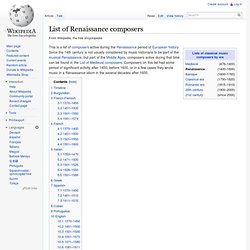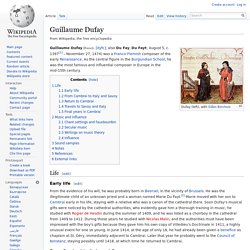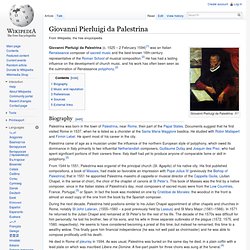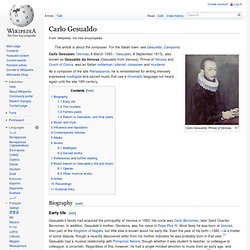

Renaissance music. Musicians, ca 1600 Renaissance music is music written in Europe during the Renaissance.

Consensus among music historians – with notable dissent – has been to start the era around 1400, with the end of the medieval era, and to close it around 1600, with the beginning of the Baroque period, therefore commencing the musical Renaissance about a hundred years after the beginning of the Renaissance as understood in other disciplines. As in the other arts, the music of the period was significantly influenced by the developments which define the Early Modern period: the rise of humanistic thought; the recovery of the literary and artistic heritage of ancient Greece and Rome; increased innovation and discovery; the growth of commercial enterprise; the rise of a bourgeois class; and the Protestant Reformation.
From this changing society emerged a common, unifying musical language, in particular the polyphonic style of the Franco-Flemish school. Overview[edit] Genres[edit] Theory and notation[edit] List of Renaissance composers. This is a list of composers active during the Renaissance period of European history.

Since the 14th century is not usually considered by music historians to be part of the musical Renaissance, but part of the Middle Ages, composers active during that time can be found in the List of Medieval composers. Composers on this list had some period of significant activity after 1400, before 1600, or in a few cases they wrote music in a Renaissance idiom in the several decades after 1600. Josquin des Prez. 1611 woodcut of Josquin des Prez, copied from a now-lost oil painting done during his lifetime[1] Josquin des Prez (or Josquin Lebloitte dit Desprez; French: [ʒɔskɛ̃ depʁe]; c. 1450/1455 – 27 August 1521), often referred to simply as Josquin, was a Netherlandish composer of the Renaissance.

He is also known as Josquin Desprez and Latinized as Josquinus Pratensis, alternatively Jodocus Pratensis. He himself spelled his name "Josquin des Prez" in an acrostic in his motet Illibata Dei virgo nutrix.[2][3] He was the most famous European composer between Guillaume Dufay and Palestrina, and is usually considered to be the central figure of the Franco-Flemish School. Josquin is widely considered by music scholars to be the first master of the high Renaissance style of polyphonic vocal music that was emerging during his lifetime.
Life[edit] Birth and early career[edit] Little is known for certain of Josquin's early life. Josquin Desprez - "Ave Maria" Guillaume Dufay. Guillaume Dufay (French: [dyfɛ]; also Du Fay, Du Fayt; August 5, c. 1397[1] – November 27, 1474) was a Franco-Flemish composer of the early Renaissance.

As the central figure in the Burgundian School, he was the most famous and influential composer in Europe in the mid-15th century. Life[edit] Early life[edit] From the evidence of his will, he was probably born in Beersel, in the vicinity of Brussels. He was the illegitimate child of an unknown priest and a woman named Marie Du Fayt.[2] Marie moved with her son to Cambrai early in his life, staying with a relative who was a canon of the cathedral there. From Cambrai to Italy and Savoy[edit] From November 1418 to 1420 he was a subdeacon at Cambrai Cathedral. Cardinal Aleman was driven from Bologna by the rival Canedoli family in 1428, and Dufay also left at this time, going to Rome. "Ave Maris Stella" - Guillaume Dufay. Thomas Tallis. Spem In Alium Thomas Tallis. Giovanni Pierluigi da Palestrina. Giovanni Pierluigi da Palestrina Giovanni Pierluigi da Palestrina (c. 1525 – 2 February 1594)[1] was an Italian Renaissance composer of sacred music and the best-known 16th-century representative of the Roman School of musical composition.[2] He has had a lasting influence on the development of church music, and his work has often been seen as the culmination of Renaissance polyphony.[2] Biography[edit] Palestrina was born in the town of Palestrina, near Rome, then part of the Papal States.

Documents suggest that he first visited Rome in 1537, when he is listed as a chorister at the Santa Maria Maggiore basilica. He studied with Robin Mallapert and Firmin Lebel. Palestrina came of age as a musician under the influence of the northern European style of polyphony, which owed its dominance in Italy primarily to two influential Netherlandish composers, Guillaume Dufay and Josquin des Prez, who had spent significant portions of their careers there. Palestrina : Agnus Dei. Palestrina - Stabat Mater. William Byrd. William Byrd "Agnus Dei - Mass for five voices" Carlo Gesualdo.
Carlo Gesualdo, Prince of Venosa.

Carlo Gesualdo (Venosa, 8 March 1560 – Gesualdo, 8 September 1613), also known as Gesualdo da Venosa (Gesualdo from Venosa), Prince of Venosa and Count of Conza, was an Italian nobleman, lutenist, composer and murderer. Biography[edit] Early life[edit] Gesualdo's family had acquired the principality of Venosa in 1560. His uncle was Carlo Borromeo, later Saint Charles Borromeo. In addition to Nenna, Gesualdo's accademia included the composers Giovanni de Macque, Scipione Dentice, Scipione Stella, Scipione Lacorcia, Ascanio Mayone, and the nobleman lutenist Ettorre de la Marra.[3] Carlo Gesualdo - Io tacero.